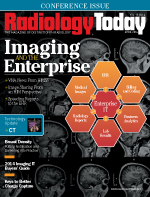 April 2014
April 2014
A Better Connection
By David Yeager
Radiology Today
Vol. 15 No. 4 P. 6
Effective communication is at the heart of any successful enterprise, but that’s especially true of health care. Whether it’s making sure that patient information is accurate, keeping referrers apprised of a patient’s condition, or delivering appropriate care, communication is essential. It requires systems that facilitate accurate and timely exchange of information to support efficient workflow.
Every medical facility is looking for opportunities to work smarter. University Diagnostic Medical Imaging (UDMI) in the Bronx, New York, is no different. The facility already uses electronic workflow tools for internal communication, from scheduling and transcription to billing and tracking patient movement along the chain of care. But UDMI’s drive for efficiency extends to external communication as well. One way it’s trying to do that is by sending radiology reports directly to referrers’ EHRs, making them immediately available to referring physicians.
UDMI still faxes some reports, but for referrers who have an EHR, UDMI can send the report instantaneously over the Internet using the secure file transfer protocol (SFTP). Robert Klein, UDMI’s administrator, says the practice frequently is asked to send reports at a moment’s notice, and the SFTP method saves staff significant time and manpower. Overall, the ability to send reports digitally has had a trickle-down effect on UDMI’s entire staff.
“We’re a busy practice. The fax queue’s never empty; it’s always got documents waiting to go out,” Klein says. “Electronic delivery definitely adds a lot of efficiency to delivering reports.”
To accomplish this, UDMI uses Advanced Data Systems Corporation’s (ADS) MedicsConnect feature, which is part of ADS’ MedicsRIS. The feature uses an HL7 standard interface that’s compatible with a referring physician’s EHR, regardless of whose EHR the referrer uses. The reports are sent straight from UDMI’s RIS, and the referrer can configure the EHR to automatically download the data to the appropriate patient file.
Klein says this allows referrers to take action immediately. Electronic delivery also has reduced the number of reports that need to be re-sent. For a practice that sends more than 100,000 reports per year, that’s important.
Making Work Flow
The biggest barrier to implementing this electronic workflow may come as a surprise. Klein says that, by far, getting people to make the electronic connection has been the most challenging aspect of the process. UDMI’s clients generally are well-established practices, and many are in no hurry to change. “It’s not initially at their highest level of importance; they’ve got many other challenges in running their practices,” he says. “So getting the commitment to take the effort to supply the proper routing, which isn’t very hard, has been a slow process.”
Klein says ADS has been helpful in communicating with UDMI’s referrers, publishing technical standards and providing technical support to get the interfaces up and running. Although it’s taking time, they’re making progress. He notes that while established practices may not be adopting the technology quickly, newer practices tend to be more enthusiastic. “For the younger crowd, this is what they expected,” he says. “For those who graduated from medical school within the last five years and who have learned on various electronic platforms, they have an expectation that the reports should arrive in a simple and electronic way. So I think we’re meeting an expectation for the younger docs, and we’re creating a better, unexpected workflow for the more established practices.”
As UDMI continues to develop outgoing connections, Klein says there are plans for incoming connections as well. He says the next step is to enable electronic ordering from referrers. UDMI has a portal in place that will receive the orders, but the system isn’t running yet.
A large hurdle is looming, though. The switch to ICD-10 later this year will complicate both sending reports and receiving orders. Klein expects it to be the most significant challenge for health care in the past 10 years. While many organizations still are digesting the Affordable Care Act and related HIPAA changes, it may take a little more time and support to figure out how to advance electronic communication.
“You need a dedicated partner to make this transition to the electronic world, somebody who has the resources and the staff to be able to make these connections work for you,” Klein says. “Without that—the ability to get the confidence of the physician groups at the other end and make this happen expeditiously—it just doesn’t work in the real world.”
— David Yeager is a freelance writer and editor based in Royersford, Pennsylvania. He writes primarily about imaging IT for Radiology Today.

